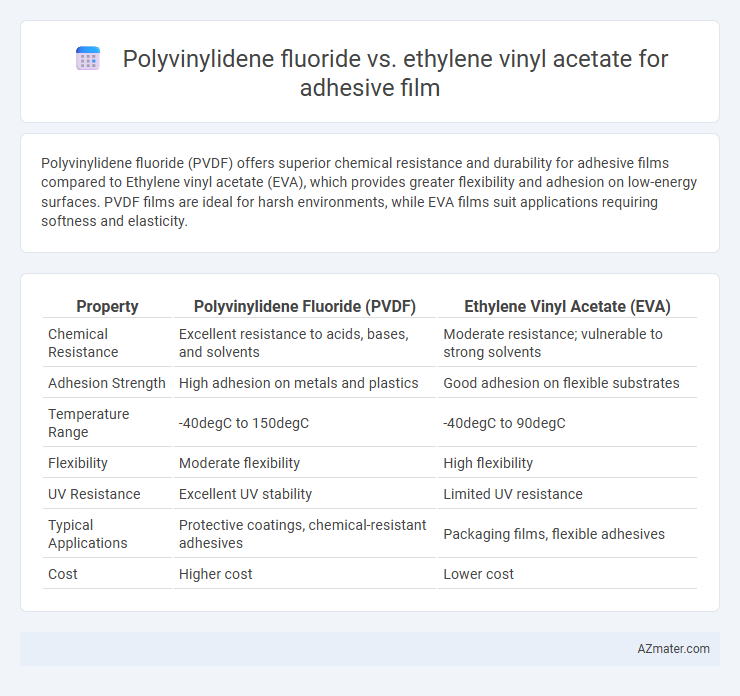Polyvinylidene fluoride (PVDF) offers superior chemical resistance and durability for adhesive films compared to Ethylene vinyl acetate (EVA), which provides greater flexibility and adhesion on low-energy surfaces. PVDF films are ideal for harsh environments, while EVA films suit applications requiring softness and elasticity.
Table of Comparison
| Property | Polyvinylidene Fluoride (PVDF) | Ethylene Vinyl Acetate (EVA) |
|---|---|---|
| Chemical Resistance | Excellent resistance to acids, bases, and solvents | Moderate resistance; vulnerable to strong solvents |
| Adhesion Strength | High adhesion on metals and plastics | Good adhesion on flexible substrates |
| Temperature Range | -40degC to 150degC | -40degC to 90degC |
| Flexibility | Moderate flexibility | High flexibility |
| UV Resistance | Excellent UV stability | Limited UV resistance |
| Typical Applications | Protective coatings, chemical-resistant adhesives | Packaging films, flexible adhesives |
| Cost | Higher cost | Lower cost |
Overview of Adhesive Films: Polyvinylidene Fluoride and Ethylene Vinyl Acetate
Polyvinylidene fluoride (PVDF) adhesive films exhibit exceptional chemical resistance, UV stability, and thermal durability, making them ideal for harsh environmental applications. Ethylene vinyl acetate (EVA) adhesive films offer superior flexibility, excellent adhesion to a wide range of substrates, and cost-effective processing, commonly used in solar panel lamination and packaging. Both materials deliver unique performance benefits, with PVDF favored for long-term outdoor exposure and EVA preferred for versatile industrial bonding needs.
Chemical Structure and Fundamental Differences
Polyvinylidene fluoride (PVDF) is a highly non-reactive and pure thermoplastic fluoropolymer characterized by repeating units of -(CH2-CF2)-, which imparts excellent chemical resistance, UV stability, and thermal endurance, making it suitable for harsh environmental adhesive applications. Ethylene vinyl acetate (EVA), a copolymer comprised of ethylene and vinyl acetate monomers, offers flexibility, good adhesion, and softening behavior due to its partially polar vinyl acetate groups and semicrystalline ethylene segments. The fundamental difference lies in PVDF's strong C-F bonds providing chemical inertness and high durability versus EVA's more flexible, rubber-like structure that ensures better tackiness and impact resistance in adhesive films.
Mechanical Properties Comparison
Polyvinylidene fluoride (PVDF) exhibits superior tensile strength and chemical resistance compared to Ethylene vinyl acetate (EVA), making it ideal for applications requiring durable adhesive films under harsh conditions. EVA offers greater flexibility and elongation at break, enhancing performance in applications requiring elasticity and impact absorption. The mechanical robustness of PVDF supports higher load-bearing capacity, whereas EVA provides better cushioning and adhesion on irregular surfaces.
Adhesion Strength and Bonding Performance
Polyvinylidene fluoride (PVDF) adhesive films exhibit superior adhesion strength and chemical resistance, making them ideal for demanding industrial applications requiring durable, long-lasting bonds. Ethylene vinyl acetate (EVA) adhesive films provide excellent bonding performance on flexible substrates with strong elasticity but generally offer lower adhesion strength compared to PVDF, particularly under environmental stresses such as UV exposure and temperature variations. PVDF's higher molecular weight and crystalline structure result in better mechanical stability and bond integrity over time, while EVA remains favored for cost-effective, flexible bonding solutions.
Thermal Stability and Temperature Resistance
Polyvinylidene fluoride (PVDF) adhesive films exhibit superior thermal stability with continuous service temperatures up to 150degC and short-term resistance near 175degC, making them ideal for high-temperature applications. Ethylene vinyl acetate (EVA) films typically withstand lower temperatures, with continuous service limits around 80degC to 90degC and short-term peaks up to 120degC, suitable for less demanding thermal environments. PVDF's enhanced crystalline structure provides greater temperature resistance and chemical durability compared to the more flexible but thermally less stable EVA.
Chemical Resistance: PVDF vs. EVA
Polyvinylidene fluoride (PVDF) offers superior chemical resistance compared to Ethylene vinyl acetate (EVA), making it highly effective against acids, bases, and organic solvents commonly encountered in industrial environments. EVA demonstrates moderate chemical resistance but may degrade when exposed to harsh chemicals or prolonged UV exposure. For applications demanding long-term durability against aggressive chemicals, PVDF-based adhesive films provide enhanced protection and longevity.
Flexibility and Processability in Adhesive Applications
Polyvinylidene fluoride (PVDF) offers exceptional chemical resistance and thermal stability, but exhibits lower flexibility compared to Ethylene vinyl acetate (EVA), which provides superior elasticity and conformability for adhesive films. EVA is easier to process due to its lower melting point and better adhesion to diverse substrates, making it favorable for applications requiring flexible bonding. PVDF's higher processing temperature demands specialized equipment, limiting its use where extensive flexibility and ease of application are critical.
Durability and Longevity in Real-World Conditions
Polyvinylidene fluoride (PVDF) adhesive films exhibit superior durability and longevity compared to Ethylene vinyl acetate (EVA) due to their exceptional chemical resistance, UV stability, and thermal endurance, making PVDF ideal for harsh outdoor applications. EVA films, while flexible and cost-effective, tend to degrade faster under prolonged exposure to heat, moisture, and UV radiation, leading to reduced adhesive strength and lifespan. In real-world conditions, PVDF's resilience to environmental stressors ensures prolonged performance, whereas EVA requires more frequent replacement or maintenance.
Industry Applications and Use Cases
Polyvinylidene fluoride (PVDF) adhesive films excel in harsh industrial environments, offering superior chemical resistance and UV stability, making them ideal for aerospace, automotive, and electronics applications requiring durable and long-lasting bonds. Ethylene vinyl acetate (EVA) adhesive films provide excellent flexibility, impact resistance, and strong adhesion to various substrates, commonly used in solar panel lamination, packaging, and footwear industries. Both materials cater to distinct use cases where PVDF is preferred for extreme conditions and EVA is favored for cost-effective, versatile bonding solutions.
Environmental Impact and Sustainability Considerations
Polyvinylidene fluoride (PVDF) adhesive films exhibit superior chemical resistance and longevity, yet their production involves fluorinated polymers contributing to environmental persistence and challenging recycling processes. Ethylene vinyl acetate (EVA) adhesive films offer greater biodegradability and lower carbon footprints due to their non-fluorinated, more easily recyclable composition, making them preferable for eco-friendly applications. Sustainability assessments favor EVA for reducing environmental impact, while PVDF's durability extends product lifespan, highlighting a trade-off between ecological footprint and long-term performance.

Infographic: Polyvinylidene fluoride vs Ethylene vinyl acetate for Adhesive Film
 azmater.com
azmater.com